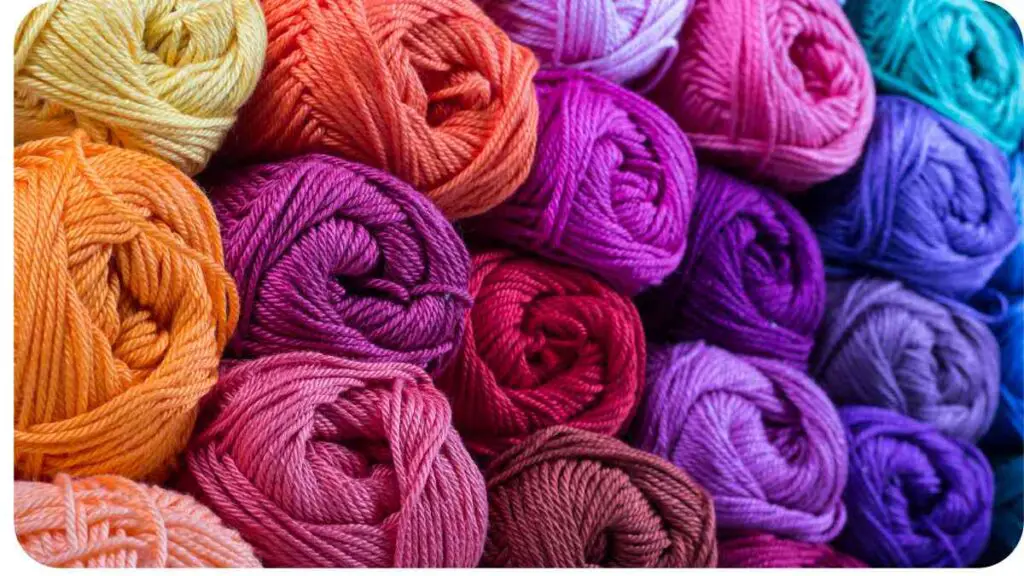Welcome to the world of yarn crafting! As an avid yarn enthusiast, you understand the importance of having a well-organized stash and keeping your precious yarn tidy.
In this article, we will delve into the art of yarn storage, providing you with valuable tips and tricks to ensure your yarn remains in perfect condition. Whether you are a beginner or a seasoned knitter, organizing your yarn stash can save you time, prevent damage, and inspire creativity. So, let’s get started!
| Takeaway |
|---|
| Clear plastic bins or baskets with lids are ideal for keeping yarn dust-free. |
| Utilize wall-mounted or freestanding shelves for easy access to your yarn. |
| Drawer units with dividers can help separate and organize your yarn stash effectively. |
| Canvas or fabric bags with compartments are perfect for portable yarn storage. |
| Vertical racks or hooks keep skeins visible and easy to access. |
| Sort your yarn stash by color or weight for efficient organization. |
| Utilize clear containers and label them to easily identify the contents. |
| Proper care and maintenance, such as keeping yarn clean and protecting it from moisture and strong scents, can prolong its lifespan. |
| Create a separate space for works-in-progress to avoid mixing them with your main yarn stash. |
| Consider using creative display ideas to showcase your yarn collection as decorative elements in your crafting space. |
| Invest in project bags and travel-friendly containers for on-the-go yarn storage. |
| Adjust your yarn storage methods based on different seasons and fiber types to maintain optimal conditions. |
| Labeling your yarn and maintaining an inventory system can save you time and prevent duplicate purchases. |
| Store your ongoing projects in project bags or labeled baskets to keep them organized. |
| Regularly inspect your yarn stash for pests and take necessary measures to prevent infestations. |
2. Understanding Yarn Storage Needs
Before diving into the various storage solutions available, it is essential to understand the unique needs of different yarn fibers. Wool, cotton, acrylic, and blends all have specific requirements to maintain their quality over time. Consider the following factors when determining how to store your yarn:
- Humidity: Some fibers are more prone to mildew or mold in high humidity environments, while others can become brittle in dry conditions.
- Sunlight: Direct sunlight can cause fading and discoloration in certain yarns.
- Pests: Wool is particularly vulnerable to moths and carpet beetles, which can damage your precious skeins.
- Space: Evaluate the available space in your home and identify areas where you can store your yarn stash conveniently.
“When embarking on a crochet project, it’s essential to have a clear plan in mind. Follow this guide on using crochet patterns to ensure your creations turn out just as you envision.”
Understanding these factors will help you make informed decisions when it comes to choosing the right storage solutions for your yarn collection.
| Fiber Type | Ideal Environment |
| Wool | Cool and dry |
| Cotton | Dry |
| Acrylic | Any |
| Blends | Generally dry |
3. Common Yarn Storage Mistakes

To ensure you avoid common pitfalls, let’s discuss some mistakes to avoid when storing your yarn:
Table: Common Yarn Storage Mistakes
| Mistake | Consequence |
| Storing yarn in plastic bags or airtight containers | Trapped moisture can lead to mold or mildew growth |
| Leaving yarn exposed to sunlight or artificial light | Fading or discoloration of yarn fibers |
| Failing to protect yarn from pests | Damage from moths, carpet beetles, or other insects |
| Overstuffing storage containers | Yarn can become tangled or compressed, leading to damage |
| Neglecting to label and organize yarn | Difficulty in finding specific yarn or determining quantities |
By avoiding these common mistakes, you can maintain the quality and longevity of your yarn collection.
4. Choosing the Right Storage Solution

Now that you are aware of the common mistakes to avoid, let’s explore some effective storage solutions for your yarn:
Table: Types of Yarn Storage Solutions
| Storage Solution | Description |
| Yarn Bins | Clear plastic bins or baskets with lids to keep yarn dust-free |
| Yarn Shelves | Wall-mounted or freestanding shelves for easy access and display |
| Yarn Drawers | Drawer units with dividers to separate and organize yarn |
| Yarn Bags | Canvas or fabric bags with compartments for portable storage |
| Yarn Racks | Vertical racks or hooks for hanging skeins and keeping them visible |
Choosing the right storage solution depends on factors such as your available space, the size of your yarn collection, and your personal preferences. Consider investing in storage options that provide easy access, protect your yarn from elements, and allow you to organize your stash effectively.
“Say goodbye to frustrating yarn tangles! Discover effective tips to prevent yarn tangling during your knitting and crochet projects, and enjoy smoother, hassle-free crafting sessions.”
5. Organizing Your Yarn Stash
Keeping your yarn stash organized is crucial for easy usage and an enjoyable crafting experience. Here are some tips to help you keep your yarn neat and accessible:
- Sort by color or weight: Arrange your yarn by colors or weights, making it easier to find the right yarn for your project.
- Utilize clear containers: Clear plastic bins or bags allow you to see the contents without opening them.
- Label your storage: Use labels or tags to identify the contents of each storage container, reducing the time spent searching for specific yarn.
- Separate ongoing projects: Set aside a designated space for works-in-progress (WIPs) to keep them separate from your main stash.
By implementing these organizing strategies, you can streamline your creative process and eliminate the frustration of searching for the perfect yarn.
6. Proper Care and Maintenance
Ensuring the longevity of your yarn also involves proper care and maintenance. Follow these guidelines to keep your yarn in pristine condition:
- Keep it clean: Before storing your yarn, make sure it is clean and free from dust or debris.
- Avoid strong scents: Yarn can absorb strong odors, so store it away from perfumes, smoke, or kitchen odors.
- Protect from moisture: Use moisture-absorbing sachets or silica gel packets to prevent moisture buildup.
- Rotate your stash: Periodically go through your yarn stash to check for any signs of damage or pests and discard any compromised skeins.
Taking care of your yarn collection will ensure its longevity and help you maintain the quality of your projects.
“Picking the right yarn can make or break your crochet project. Learn how to select the perfect yarn that suits your design and ensures a beautiful and successful outcome.”
7. Creative Display Ideas
While it’s important to store your yarn properly, you can also use your collection as a decorative element in your crafting space. Consider these creative display ideas:
- Yarn wall art: Create a unique piece of wall art by wrapping different colored yarn around a wooden embroidery hoop or frame.
- Yarn jars: Fill glass jars or vases with colorful yarn balls and use them as vibrant decorations on shelves or tables.
- Yarn rainbow: Arrange your yarn by color in a gradient pattern to create a stunning visual display.
- Yarn baskets: Place your most beautiful skeins in decorative baskets or bowls for an eye-catching arrangement.
These display ideas not only add a visual appeal to your space but also showcase your love for yarn crafting.
8. Tips for On-the-Go Yarn Storage
As a yarn enthusiast, you may want to take your projects on the go. Here are some tips for portable yarn storage:
- Yarn project bags: Invest in project bags specifically designed to carry your yarn and ongoing projects. Look for bags with pockets for accessories and compartments to keep skeins separate.
- Ziplock bags: Use small ziplock bags to hold individual yarn balls, preventing them from unraveling or getting tangled in transit.
- Travel-friendly containers: Look for compact containers that can hold your yarn and fit easily in your bag, such as snack containers or pencil cases.
- Cable organizers: Utilize cable organizers or cord wraps to keep your knitting or crochet hooks organized and tangle-free.
With these tips, you can craft on the go without worrying about unraveling yarn or misplacing your tools.
“Uneven knitting can be a common frustration for beginners. Explore the reasons behind uneven knitting and find expert solutions to achieve more consistent and polished results in your knitting projects.”
9. Storing Yarn for Different Seasons
Depending on the climate and changing seasons, you may need to modify your yarn storage methods. Consider these tips for storing yarn during different seasons:
- Summer: During hot and humid weather, ensure your storage area is cool and dry. Consider using moisture-absorbing products to prevent mold or mildew.
- Winter: Dry winter air can make yarn fibers brittle. Place a small humidifier near your storage area to maintain the necessary moisture levels.
- Seasonal rotation: Use the change of seasons as an opportunity to assess your stash, declutter, and rotate yarn to ensure you’re using the most appropriate fibers for the upcoming months.
Adapting your yarn storage to the seasons can help preserve the quality of your yarn and ensure optimal crafting conditions.
“Planning your yarn quantities is crucial for any knitting or crochet project. Gain insights into determining the right amount of skeins you’ll need, ensuring you have enough yarn for a seamless crafting experience.”
10. Storing Yarn for Different Fiber Types
Different yarn fibers require specific storage considerations to maintain their quality. Here are tips for storing common yarn fiber types:
Table: Storage Tips for Different Yarn Fiber Types
| Fiber Type | Storage Tips |
| Wool | Store in breathable containers, such as cotton or linen bags, to prevent moisture buildup. Add lavender sachets to deter pests. |
| Cotton | Keep in a dry environment to prevent potential moisture absorption. Use sealed storage containers or vacuum-sealed bags to protect from pests. |
| Acrylic | Acrylic yarn is less susceptible to moisture and pests. Store in airtight containers to prevent dust accumulation. |
| Blends | Follow the storage guidelines of the dominant fiber in the blend. Consider the requirements of both fibers for proper care. |
Adhering to these storage tips will help preserve the quality and longevity of your yarn, ensuring optimal results in your projects.
11. Storing Yarn by Color or Weight
Organizing your yarn by color or weight can make it easier to find the perfect skein for your projects. Consider these methods for organizing your yarn stash:
- Color-based organization: Sort your yarn by color in separate containers or shelves. You can arrange them in a color spectrum or group similar hues together.
- Weight-based organization: Categorize your yarn by weight, such as lace, fingering, DK, worsted, or bulky. Use labeled dividers or separate drawers to keep them organized.
By organizing your yarn in a way that makes sense to you, you’ll spend less time searching for the right yarn and more time enjoying your crafting.
12. Protecting Yarn from Dust and Pests
Keeping your yarn stash dust-free and protected from pests is crucial. Follow these tips to safeguard your precious skeins:
- Sealed storage containers: Use airtight containers or vacuum-sealed bags to prevent dust accumulation and protect against pests.
- Use lavender or cedar: Place lavender sachets or cedar balls among your yarn to naturally deter moths and other yarn-loving insects.
- Regular inspection: Periodically check your yarn stash for any signs of pests. If you notice any damage or infestation, take immediate action to prevent further spread.
With these proactive measures, you can ensure that your yarn remains pristine and free from unwanted intruders.
13. Utilizing Labels and Inventory Systems
Labeling your yarn and implementing an inventory system can save you time and frustration when searching for specific skeins. Consider the following strategies:
- Label your storage containers: Use labels or tags to identify the contents of each storage container. Include important details such as yarn weight, color, and fiber type.
- Create a yarn inventory: Keep track of your yarn collection by creating a detailed inventory. You can use a simple spreadsheet or utilize digital inventory apps to track your yarn stash. Record information such as brand, color, weight, yardage, and any project ideas associated with each skein.
With a well-organized labeling and inventory system, you’ll be able to find the perfect yarn for your projects efficiently and avoid purchasing duplicates.
14. Storing WIPs (Works in Progress)
Managing your works-in-progress (WIPs) and keeping them organized is essential for a clutter-free crafting space. Here are some tips for storing your ongoing projects:
- Project bags: Invest in project bags designed specifically for WIPs. These bags often have compartments to store your yarn, needles/hooks, and pattern.
- Use storage baskets: Place each WIP in its own basket or bin, along with the necessary yarn and tools. This keeps everything together and makes it easy to grab and continue working on your projects.
- Label your WIPs: Attach labels or tags to your WIPs indicating the project name, pattern, and relevant details. This saves time and helps you quickly identify your ongoing projects.
By organizing and storing your WIPs, you’ll have a clutter-free space and be able to easily pick up where you left off on your projects.
15. Frequently Asked Questions
To address some common concerns, let’s answer a few frequently asked questions about yarn storage:
Table: Frequently Asked Questions
| Question | Answer |
| How do I prevent my yarn from tangling? | Store your yarn in separate, sealed containers or use yarn bowls to prevent tangling. You can also place each skein in a small ziplock bag and feed the working yarn through a small hole in the bag to keep it separated and easily accessible. |
| Can I store yarn in the basement or attic? | Basements and attics are more susceptible to temperature and humidity fluctuations. If |
Further Reading
Here are some additional resources you can explore for more information on yarn storage:
- Nimble Needles: How to Store Yarn: This website provides tips and techniques for storing different types of yarn and tools, helping you keep your yarn collection organized and in optimal condition.
- The Spruce Crafts: Yarn Storage Ideas: Discover a variety of creative and practical yarn storage ideas, from DIY solutions to specialized storage products, to keep your yarn stash neat and accessible.
- HandKnitty: Knitting Yarn Organized and Tidy: This article offers advice on how to organize and store your yarn collection efficiently, as well as ideas for creating a functional and visually appealing yarn storage space.
FAQs
Here are some frequently asked questions about yarn storage:
How do I prevent my yarn from tangling?
To prevent tangling, store your yarn in separate, sealed containers or use yarn bowls to keep them organized. You can also place skeins in individual ziplock bags, feeding the working yarn through a small hole in the bag to keep it separated and easily accessible.
Can I store yarn in basements or attics?
Basements and attics are generally not ideal for yarn storage due to temperature and humidity fluctuations. It’s best to store yarn in a cool, dry area away from direct sunlight and extreme conditions.
Does acrylic yarn require special storage?
Acrylic yarn is less susceptible to moisture and pests but should still be stored in airtight containers to prevent dust accumulation. This helps maintain the yarn’s quality and prevents potential discoloration.
How do I protect my yarn from moths and pests?
To protect your yarn from moths and pests, use lavender sachets, cedar balls, or other natural deterrents. Store yarn in airtight containers and periodically inspect your stash for any signs of infestation.
How should I store my WIPs (Works in Progress)?
For works in progress, use project bags with compartments to keep yarn, needles, and patterns together. If using multiple project bags, label them with the project name and details to easily identify and retrieve your WIPs.
Remember, proper storage and organization help maintain the quality of your yarn and make your crafting experience more enjoyable.

My name is Hellen James, and I’m a crochet and knitting expert. I’ve been crocheting since I was just a kid, but I started taking it seriously when I realized that it was a great way to de-stress and relax. Now that I have kids of my own, I love teaching them how to do it too!

